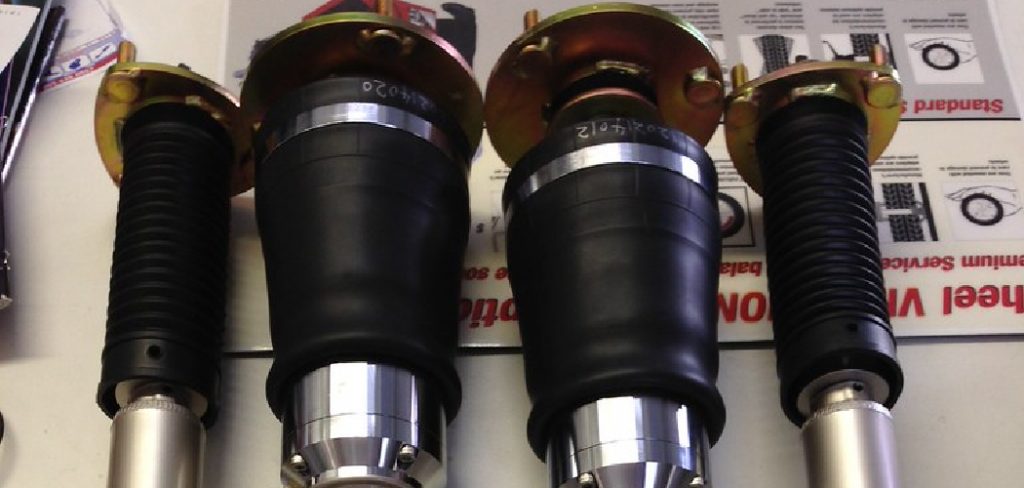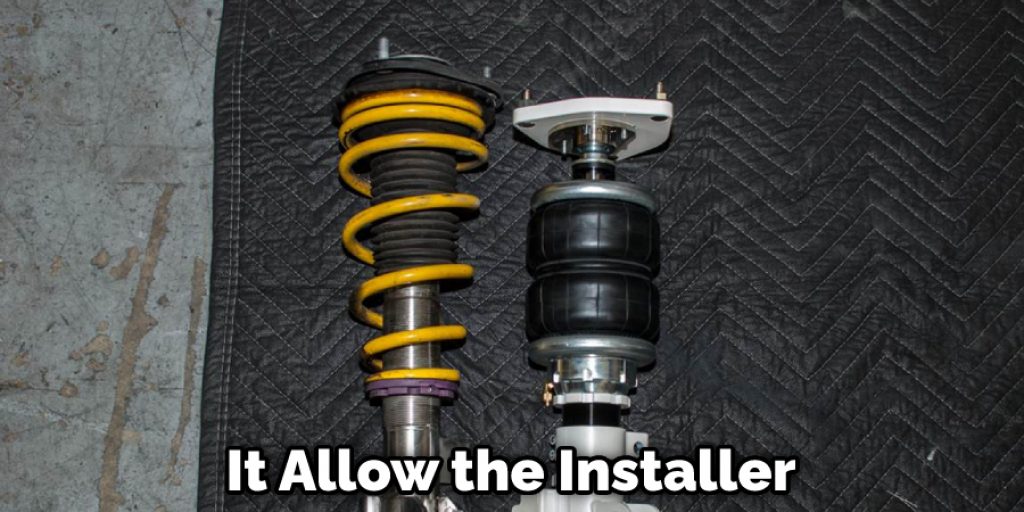In this blog post, we will discuss how to repair hole in airbag suspension. The first step is to find the leak and patch it up. You can use a sealant or even duct tape if you’re in a bind. Once the leak is fixed, you will need to reinflate the airbag suspension.

Be sure to follow the manufacturer’s instructions for your specific vehicle. Finally, test out the suspension and make sure it’s working correctly. With patience and some basic tools, you can easily fix a hole in your airbag suspension. Read on to know more!
Summary: Repairing a hole in airbag suspension requires several tools including a drill, a tap, an airbag compressor, and an air hose. Begin by drilling two holes in the old mounting plate and tapping them with the appropriate drill bit and tap.
Then install the new airbag in place while pressing it down firmly to ensure it is set adequately. Lastly, attach the air compressor to the vehicle’s existing system and run it until there is no more leakage.
What Is an Air Bag Suspension
An airbag suspension is an automobile-specific spring suspension where metal coils are compressed by an airbag, which provides the force necessary to maintain vehicular stability during high-speed driving.
This helps to reduce the risk of rollover by keeping vehicle weight on its tires and making it possible for a car to absorb bumps and ditches in the road more effectively. It is used by several manufacturers, including Ford, Nissan, Jeep, and BMW.
How Does an Airbag Suspension Work
Airbags keep passengers in the car during crashes by cushioning them from impact. Airbag suspensions are designed to absorb bumps and potholes, preventing the airbags from deploying unnecessarily. This helps to protect light-weight cars from being jarred too much by the road.
Larger potholes can cause airbags to deploy. Airbags are housed inside the rear wheel wells. If you hit a pothole that causes the tire to scrape against a wheel well, the airbags will deploy because the scraping action has caused a sharp enough movement to set off the sensors.
Types of Air Bag Suspension Systems
There are two main types of airbag suspension systems.
1. Coil-Over Air Bag Suspensions:
Coil-over systems allow the installer to adjust the ride height of the vehicle. This is accomplished by adding or removing preload on the top spring seat. This type of system has more components than the inline style, making it slightly more expensive. It is also slightly more complicated to install.

2. Inline Air Bag Suspensions:
This system is cheaper and easier to install than the coil-over style because it has fewer components. However, you cannot adjust the car’s height with this system, so it can only be used on level applications.
Step by Step Process: How to Repair Hole in Airbag Suspension
Step 1: Identify the Issue
Begin by inspecting the airbag suspension for visible signs of damage or wear. Pay close attention to the airbags themselves, looking for holes, cracks, or abrasions. If you’re unsure about the source of the problem, consult a professional mechanic or technician for assistance.
Step 2: Gather Necessary Tools and Materials
To repair a hole in an airbag suspension, you will need the following tools and materials:
- Jack and jack stands or a vehicle lift
- Wheel chocks
- Socket set and wrenches
- Airbag repair kit or appropriate patching material
- Scissors or utility knife
- Sandpaper or abrasive pad
- Rubber gloves
- Alcohol or cleaning solution
- Clean cloth or rags
- Tire inflater or air compressor
- Soapy water
- Tire pressure gauge
Step 3: Prepare the Vehicle
Ensure the vehicle is parked on a flat and stable surface. Use wheel chocks to prevent the vehicle from moving during the repair process. Use a jack and jack stands or a vehicle lift to raise the vehicle to the appropriate height for accessing the airbag suspension. Make sure the suspension system is fully deflated before beginning the repair.
Step 4: Locate the Damaged Airbag
Find the airbag with the hole or damage. Carefully inspect the entire airbag for any additional damage that may need to be addressed during the repair process.
Step 5: Clean and Dry the Damaged Area
Put on rubber gloves and use a clean cloth or rag soaked in alcohol or cleaning solution to thoroughly clean the area around the hole or damage. Ensure all dirt, grease, and debris are removed from the surface. Allow the area to dry completely before proceeding with the repair.
Step 6: Sand the Damaged Area
Using sandpaper or an abrasive pad, gently sand the area around the hole or damage. This will create a rough surface, which will help the patch adhere more effectively. Be careful not to sand too aggressively, as this may cause additional damage to the airbag.
Step 7: Prepare the Patch
If using an airbag repair kit, follow the manufacturer’s instructions for preparing the patch. If using an alternative patching material, cut a piece of material large enough to cover the hole or damage, with at least a 1-inch (2.5 cm) border on all sides.
Step 8: Apply the Patch
Peel off any backing from the adhesive side of the patch and carefully position it over the hole or damage. Press firmly on the patch, ensuring it adheres smoothly and securely to the airbag’s surface. Make sure there are no bubbles or wrinkles in the patch.
Step 9: Allow the Patch to Cure
Follow the manufacturer’s instructions for the appropriate curing time for the patch. This may vary depending on the specific repair kit or patching material used. Do not inflate the airbag suspension or put any weight on the vehicle during the curing process.
Step 10: Reinflate the Airbag Suspension
Once the patch has cured, use a tire inflater or air compressor to reinflate the airbag suspension to the manufacturer’s recommended pressure. Use a tire pressure gauge to ensure the airbag is inflated correctly.
Step 11: Check for Leaks
Prepare a soapy water solution and apply it to the patched area using a clean cloth or sponge. Observe the area closely for any bubbles that may form, indicating a leak in the patched area. If no leaks are present, the repair was successful. If you notice any leaks, deflate the airbag suspension, remove the patch, and repeat steps 5 through 11 to ensure a proper seal.
Step 12: Lower the Vehicle and Remove Wheel Chocks
Once you are confident that the repair is successful and there are no leaks, carefully lower the vehicle back onto the ground using the jack and jack stands or vehicle lift. Remove the wheel chocks.
Step 13: Test Drive the Vehicle
Take the vehicle for a short test drive to ensure that the airbag suspension is functioning correctly and providing a smooth ride. Pay attention to any unusual noises or handling characteristics, which may indicate further issues with the suspension system.
Step 14: Monitor the Airbag Suspension
Over the next few days or weeks, regularly check the repaired airbag for any signs of leaks or further damage. If you notice any issues, consult a professional mechanic or technician for further assistance.
By following these steps, you can effectively repair a hole or damage in an airbag suspension, ensuring a smooth and comfortable ride for your vehicle. However, it’s essential to remember that some repairs may be beyond the scope of a DIY repair, and in those cases, it’s best to consult a professional for assistance.
Some Helpful Tips and Suggestions
Here are some helpful tips on how to repair hole in airbag suspension.
- You are at risk for injury if you are careless
- Always wear safety goggles when using any tools or equipment, including permanent markers and masking tape
- If you lose a bolt, nut, screw, etc., do not attempt to use it again; replace it with another matching item immediately
- Use the proper size socket or wrench, don’t use a socket wrench when you need a spanner wrench and vice versa.
- When connecting wires, make sure you use the correct wire connectors.
- Soldering takes practice and patience, don’t give up if it doesn’t work the first time.
- When drilling a hole in the metal or plastic, always clamp down your work piece on both sides to prevent warping from the pressure of the drill bit pushing on it.
- When soldering wires, keep your solder away from the metal because if you get any on the metal, it will cause oxidation over time.
What Are the Signs of an Airbag Suspension Problem
A car with an airbag suspension problem will have difficulty keeping its tires pressed firmly against the road during high-speed driving, increasing the risk of rollover. It may also experience a bumpy ride when encountering bumps in the street, or feel more like a truck than a car. There may also be some warning light or alarm activated in the cabin, often accompanied by a loud beeping noise.
Since the airbag suspension is part of the car’s safety system, getting your car repaired as soon as you experience any problems is very important. When the airbag suspension fails, there is a much greater risk that the vehicle will roll over in an accident. Additionally, there may be too little pressure in an airbag suspension when you need it most.
Can an Airbag Suspension Be Repaired
While an airbag suspension is designed to be strong and durable, wear and tear can result in holes. There are a few options to repairing a hole in an airbag suspension, including using an air mattress or bicycle inner tube patch. Each method is fairly easy and will not require any special tools.
Before starting the repair process, determine what caused the hole. For example, a sharp object may have punctured the bag during the installation of another car part, such as a new radio. The metal in the car may have worn away with time, which can be repaired by attaching a patch to the inside of the bag.
You Can Check It Out to: Repair Wet Brakes on Ford Tractor
Frequently Asked Questions
Can You Patch Air Bags?
It depends on the make and model of the airbag, as well as the severity of the leak. In some cases, it may be possible to seal off small leaks using a rubber band or other type of closure device. However, larger holes that have caused structural damage may require more extensive repair procedures.
How Much Is Airbag Suspension Repair?
Airbag suspension repair can cost anywhere from $200 to $2,000+, and a reputable mechanic will always charge you for the cost of their expertise. This includes everything from inspection and testing to installation and repairs. airbags are one of the most important safety features in a car, but they can also be costly to maintain.
When your airbag is triggered, it deploys abruptly upward, which may cause damage or even serious injuries inside the vehicle. If this happens in traffic, you could find yourself facing expensive legal bills as well as physical injuries that may require surgery or long-term medication treatments.
Can Air Shocks Be Repaired?
Every air shock is different, and some may be easier to repair than others. Some tips that may help include checking the fluid level, inspecting the seals and mounting plates, and replacing any worn or damaged components. If you are unable to repair the air shock yourself, you may wish to consider sending it in for repair.
Is a Car Totalled when the Airbag Deploys?
Yes, a car is totaled when the airbag deploys. This occurs when the sensors that are designed to detect an impending collision trigger the airbag system.
Conclusion
Airbag suspension is a system that uses compressed air to keep a vehicle’s tires in contact with the road. This system is used on many different vehicles, including cars, trucks, and buses. Unfortunately, airbag suspension systems are often susceptible to damage from potholes and other roadway hazards.

When an airbag suspension system is damaged, it can be difficult and expensive to repair. In this article, we have discussed how to repair hole in airbag suspension. If you have a hole in your airbag suspension system, you will need to patch it as soon as possible. We hope this blog post has been helpful. If you have any questions or want to know more, then feel free to comment below!
You Can Check It Out to: Repair Small Tear in Car Headliner
